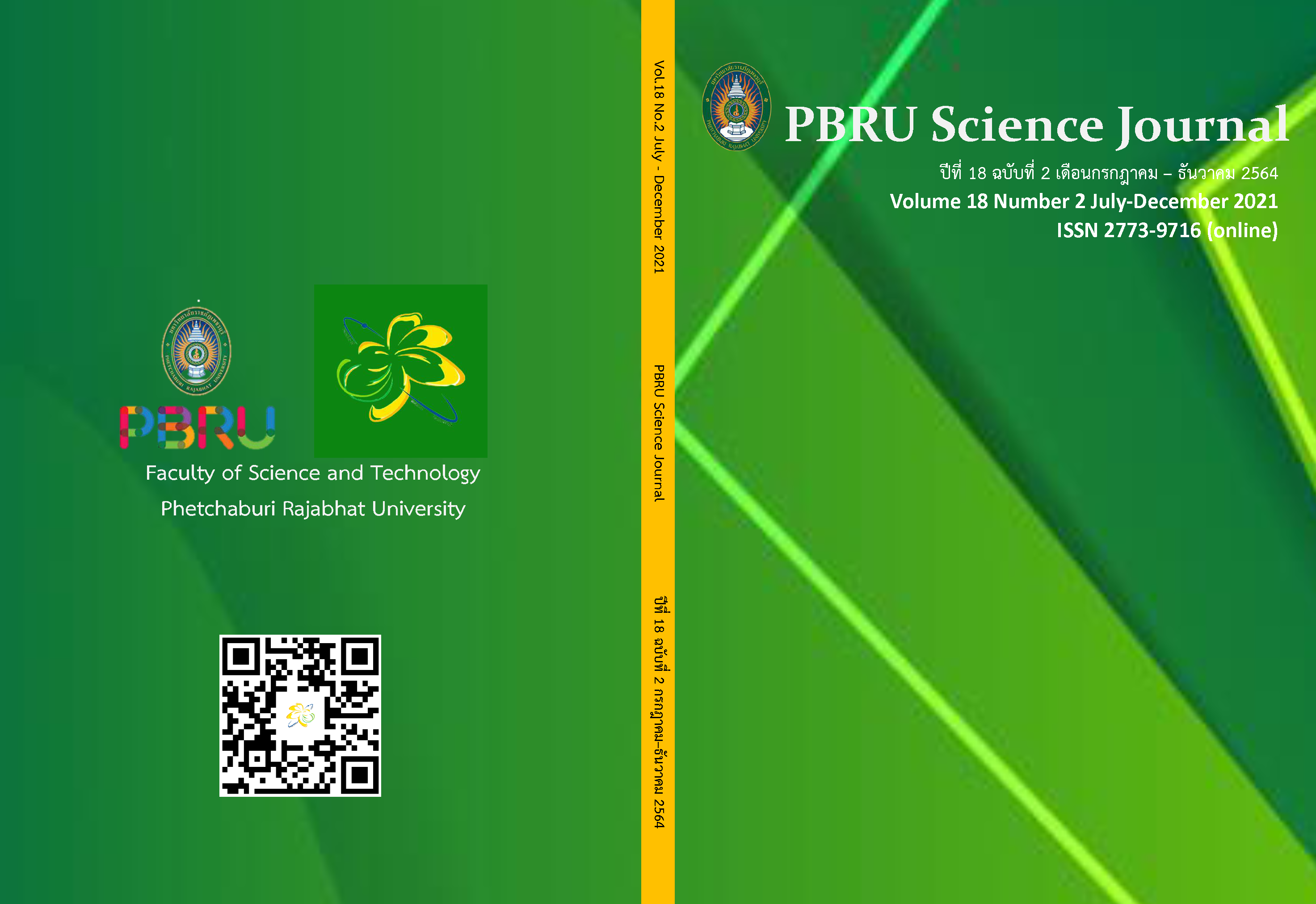คุณสมบัติในการเป็นโพรไบโอติกของแบคทีเรียกรดแลคติกที่คัดแยกได้จากผลิตภัณฑ์เนื้อหมัก
Main Article Content
บทคัดย่อ
การศึกษานี้มีวัตถุประสงค์เพื่อคัดแยกแบคทีเรียกรดแลคติกจากผลิตภัณฑ์เนื้อหมัก ได้แก่ แหนมหมู แหนมวัว ไส้กรอกหมูและไส้กรอกวัว ศึกษาลักษณะทางสัณฐานวิทยา สรีรวิทยาและคุณสมบัติในการเป็นโพรไบโอติก ของแบคทีเรียกรดแลคติกที่คัดแยกได้ ได้แก่ ความสามารถในการยับยั้งการเจริญของแบคทีเรียก่อโรค การทนต่อสภาวะกรด การทนต่อเกลือน้ำดีและความไวต่อยาปฏิชีวนะ จากผลิตภัณฑ์เนื้อหมัก 4 ตัวอย่าง สามารถคัดแยกแบคทีเรียกรดแลคติกได้ทั้งหมด 30 ไอโซเลท พบว่ามีแบคทีเรียกรดแลคติกจำนวน 9 และ 8 ไอโซเลทที่มีฤทธิ์ ในการยับยั้ง Staphylococcus aureus DSMZ799 และ Bacillus cereus ATCC 11778 ตามลำดับ แต่ทุกไอโซเลทไม่มีฤทธิ์ในการยับยั้ง Escherichia coli DSMZ682 ฤทธิ์ในการยับยั้งจุลินทรีย์เกี่ยวข้องกับกรดอินทรีย์และสารที่มีสมบัติคล้ายโปรตีน เมื่อนำแบคทีเรียกรดแลคติกที่มีฤทธิ์ในการยับยั้งแบคทีเรียมาทดสอบความสามารถในการทนต่อสภาวะกรดที่มีค่าพีเอชเท่ากับ 2 ระยะเวลา 240 นาที และทนต่อเกลือน้ำดี 0.45% ระยะเวลา 180 นาที พบว่ามีร้อยละการรอดชีวิต ระหว่าง 0 ถึง 52.97 และ 82.17 ถึง 98.41 ตามลำดับ ความไวต่อยาปฏิชีวนะ ชนิดต่าง ๆ ของแบคทีเรียที่ทดสอบมีความแตกต่างกัน มีแบคทีเรียกรดแลคติกเพียง 1 ไอโซเลท ได้แก่ ไอโซเลท NHB05-01 ที่คัดแยกได้จากแหนมวัวที่มีแนวโน้มว่ามีคุณสมบัติเป็นโพรไบโอติก
Article Details

อนุญาตภายใต้เงื่อนไข Creative Commons Attribution-NonCommercial-NoDerivatives 4.0 International License.
บทความที่ได้รับการตีพิมพ์เป็นลิขสิทธิ์ของ PBRU Science Journal
เอกสารอ้างอิง
Swetwiwathana A, Visessanguan W. Potential of bacteriocin-producing lactic acid bacteria for safety improvements of traditional Thai fermented meat and human health. Meat Science 2015;09:101-5.
Williams NT. Probiotics. American Journal of Health-System Pharmacy 2010;7(6):449-58.
Salminen S, Ouwehand A, Benno Y, Lee YK. Probiotics: how should they be defined? Trends in Food Science & Technology 1999;10(3):107-10.
Kechagia M, Basoulis D, Konstantopoulou S, Dimitriadi D, Gyftopoulou K, Skarmoutsou N, Fakiri EM. Health benefits of probiotics: a review. International Scholarly Research Notices nutrition 2013;481651. doi:10.5402/2013/481651.
Saarela M, Mogensen G, Fondén R, Mättö J, Mattila-Sandholm T. Probiotic bacteria: safety, functional and technological properties. Journal of Biotechnology 2000;84(3):197-215.
Holzapfel WH, Haberer P, Snel J, Schillinger U, Huis in't Veld JH. Overview of gut flora and probiotics. International Journal of Food Microbiology 1998;41(2):85-101.
ปาริชาติ พุ่มขจร, พงศ์ศักดิ์ รัตนชัยกุลโสภณ. การตรวจแยกแล็กติกแอซิดแบคทีเรียที่มีศักยภาพเป็นโพรไบโอติกจากอาหารหมัก. วารสารวิทยาศาสตร์และเทคโนโลยี มหาวิทยาลัยมหาสารคาม 2563;39(2):206-12.
นนทพร รัตนจักร์. การคัดแยกและศึกษาคุณสมบัติการเป็นโพรไบโอติกของแบคทีเรียกรดแลคติกที่คัดแยกจากกล้วยน้ำว้าดิบในเขตจังหวัดพิษณุโลก. วารสารวิทยาศาสตร์และเทคโนโลยี มหาวิทยาลัยอุบลราชธานี 2563;22(2):50-7.
Botthoulath V, Upaichit A, Thumarat U. Identification and in vitro assessment of potential probiotic characteristics and antibacterial effects of Lactobacillus plantarum subsp. plantarum SKI19, a bacteriocinogenic strain isolated from Thai fermented pork sausage. Journal of Food Science and Technology 2018;55: 2774-85.
Schillinger U, Lücke FK. Antibacterial activity of Lactobacillus sake isolated from meat. Applied and Environmental Microbiology. 1989;55(8):1901-6.
Martirani L, Varcamonti M, Naclerio G, De Felice M. Purification and partial characterization of bacillocin 490 a novel bacteriocin produced by a thermophilic strain of Bacillus licheniformis. Microbial Cell Factories 2002;1(1):1.
Michida H, Tamalampudi S, Pandiella SS, Webb C, Fukuda H, Kondo A. Effect of cereal extracts and cereal fibre on viability of Lactobacillus plantarum under gastrointestinal tract conditions. Biochemical engineering journal 2006;28(1):73-8.
Collins CH, Lyne PM, Grange JM. Microbiological Methods. UK: Butterworth-Heinemann, Oxford; 1989.
Goderska K, Czarnecki Z. Characterization of selected strains from Lactobacillus acidophilus and Bifidobacterium bifidum. African Journal of Microbiology Research 2007;1(6):65-78.
Axelsson L. Lactic acid bacteria: classification and physiology. Food science and technology-New York-Marcel-Dekker.
Liu W, Pang H, Zhang H, Cai Y. Biodiversity of lactic acid bacteria. Lactic acid bacteria: Springer; 2014.
Hammes WP, Bantleon A, Min S. Lactic acid bacteria in meat fermentation. FEMS Microbiology Reviews 2004;7(1-2):165-73.
Mezaini A, Chihib NE, Bouras AD, Nedjar-Arroume N, Hornez JP. Antibacterial activity of some lactic acid bacteria isolated from an Algerian dairy product. Journal of environmental and public health 2009;78495. doi:10.1155/2009/678495.
Lindgren SE, Dobrogosz WJ. Antagonistic activities of lactic acid bacteria in food and feed fermentations. FEMS microbiology reviews 1990;7(1-2):149-63.
Ouwehand AC, Vesterlund S. Antimicrobial components from lactic acid bacteria. Food science and technology-New York-Marcel-Dekker; 2004.
Sharma P, Tomar SK, Goswami P, Sangwan V, Singh R. Antibiotic resistance among commercially available probiotics. Food Research International 2014;57:17

